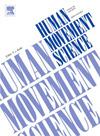两名行人通过缝隙时的相互回避行为
IF 1.9
3区 心理学
Q4 NEUROSCIENCES
引用次数: 0
摘要
在混乱的环境中,人类使用视觉信息来安全地引导运动,以避免与物体或其他人发生碰撞。当前研究的目的是检查两个年轻人在从相反的方向接近一个孔时正面相互回避的行为。假设当两个年轻人处于碰撞过程时,两个行人都能准确地感知到彼此到达时间的差异,从而预测和维持通过缝隙的通行秩序。19名年轻成人(x¯=21.35±0.49岁,男9名,女10名)参与了研究,并与一名女性研究助理(RA)(22岁,157.5 cm)进行了互动。从10米路径两侧的两个位置中的一个开始,参与者和RA被指示彼此接近,并相互决定谁将首先通过位于路径中间(5米)的孔。使用Optotrak运动分析系统收集参与者和RA的运动学主干数据。结果显示,在90.9%的试验中,步行者能够准确地感知并保持预测的穿越顺序(即预测顺序与他们观察到的穿越顺序相匹配)。这一发现表明,个体对决定和维持穿越顺序所必需的视觉信息是一致的,例如,经过第二步行者(P2)的步行者会放慢速度并偏离路径,让另一个步行者(P1)先通过门口。此外,研究还发现,在穿过光圈之前,个体在光圈和接近的人之间平均分配了他们的注视。结果表明,当两个年轻的成年人从相对的两侧接近门口时,他们可能依赖于两个光学膨胀率的耦合,或tau耦合,以确定交叉顺序,这表明反转的数量较少。而注视行为则与运动相结合,以维持路径轨迹和确定交叉顺序。本文章由计算机程序翻译,如有差异,请以英文原文为准。
Mutual avoidance behaviours of two pedestrians passing through an aperture
Humans use visual information to safely guide locomotion to avoid collisions with objects or other people within cluttered environments. The purpose of the current study was to examine head-on mutual avoidance behaviours of two young adults when approaching an aperture from opposite sides. It was hypothesized that when two young adults are on a collision course, both pedestrians would accurately perceive the difference in arrival time between one another to predict and maintain passing order through an aperture. Nineteen young adults ( years, 9 males and 10 females) participated in the study and interacted with a female research assistant (RA) (22 years, 157.5 cm). Starting at one of two locations on opposite sides of a 10 m pathway, the participant and the RA were instructed to approach one another, and mutually decide who would pass first through an aperture located halfway (5 m) along the path. Kinematic trunk data was collected from both the participant and the RA using the Optotrak motion analysis system. The results revealed that the walkers were able to accurately perceive and maintain the predicted order of crossing (i.e., predicted order matched their observed crossing order) on 90.9 % of the trials. This finding indicate that individuals are in-tune to the visual information necessary in determining and maintaining crossing order, such that the walker passing second (P2) slowed down and deviated from the path to allow the other walker (P1) to pass through the doorway first. Additionally, it was revealed that individuals distribute their gaze fixations equally between the aperture and the approaching person prior to crossing the aperture. The results suggest that when two young adults are approaching a doorway from opposite sides, they may rely on the coupling of two optical expansion rates, or tau-coupling, to determine crossing order as indicated by the low number of inversions. While gaze behaviours are coupled with locomotion to maintaining path trajectory and determining crossing order.
求助全文
通过发布文献求助,成功后即可免费获取论文全文。
去求助
来源期刊

Human Movement Science
医学-神经科学
CiteScore
3.80
自引率
4.80%
发文量
89
审稿时长
42 days
期刊介绍:
Human Movement Science provides a medium for publishing disciplinary and multidisciplinary studies on human movement. It brings together psychological, biomechanical and neurophysiological research on the control, organization and learning of human movement, including the perceptual support of movement. The overarching goal of the journal is to publish articles that help advance theoretical understanding of the control and organization of human movement, as well as changes therein as a function of development, learning and rehabilitation. The nature of the research reported may vary from fundamental theoretical or empirical studies to more applied studies in the fields of, for example, sport, dance and rehabilitation with the proviso that all studies have a distinct theoretical bearing. Also, reviews and meta-studies advancing the understanding of human movement are welcome.
These aims and scope imply that purely descriptive studies are not acceptable, while methodological articles are only acceptable if the methodology in question opens up new vistas in understanding the control and organization of human movement. The same holds for articles on exercise physiology, which in general are not supported, unless they speak to the control and organization of human movement. In general, it is required that the theoretical message of articles published in Human Movement Science is, to a certain extent, innovative and not dismissible as just "more of the same."
 求助内容:
求助内容: 应助结果提醒方式:
应助结果提醒方式:


